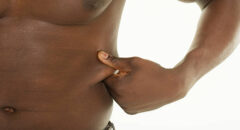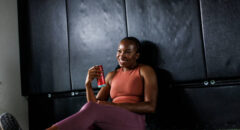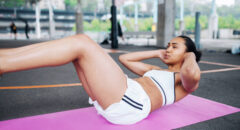
You probably already know that there's no magic formula for bigger and better biceps and triceps. Yes, you have to work for it, but there are ways to pump up in less time than you might think. With the right moves, you can build bulging arms in just two workouts a week.
A Bigger, Better, Faster Workout: The Moves
Bigger Arms: Hammer Curl
For biceps that beg to be displayed in short sleeves, start with a hammer curl. Hold dumbbells so they face your outer thighs. Exhale and bend the elbows, raising the dumbbells until their tips nearly reach your shoulders. Inhale and lower slowly. To see results, men should hit each muscle group with 3-4 different exercises, twice a week, says conditioning specialist Neal I. Pire, MA, CSCS.
Bigger Arms: Preacher Curl
This twist on the biceps curl will also work the deltoids, muscles that give shoulders a chiseled look. Rest the back of your arm on a support pad while holding a dumbbell, palm facing up. Slowly raise the dumbbell, then lower it to the starting position. If any move feels wrong, check with a qualified fitness professional. Depending on your health and physical condition, some exercises may not be recommended.
Bigger Arms: Triceps Pushdown
When building buff arms, don't neglect the underside. To do the triceps pushdown, grasp the handle with palms facing down and hands 6 inches apart. Keep your upper arms near the sides of your chest. Start with your forearms parallel to the floor. Push the cable down by straightening the arms until your elbows are fully extended, but not locked. Pause and slowly return to the starting position.
Bigger Shoulders: Front Raise
If hulking shoulders are a goal, muscle this exercise into your workout. Do it standing or seated on a bench or stability ball, with weights at your sides. Raise one straight arm to the front, up to shoulder level, while turning your palm towards the floor. Slowly lower back down. Keep an erect torso and neutral wrist position. Using one arm at a time makes it easier to keep the back straight.
Bigger Shoulders: Lateral Raise
This classic move targets the deltoids to create a rounded upper arm. Holding your dumbbells at your sides, contract the abdominals to stabilize your spine. Then sweep both arms up to shoulder level to form a "T." Keep the arms relaxed and elbows unlocked. Rotate elbows slightly outward to isolate the shoulder muscles. Slowly lower back to the starting position.
A Better, Better, Faster Workout: The Theory
Buff vs. Mr. Universe
The right weight and number of reps for you all depend on your goals, and of course your physical fitness. Beginners can start with 3 sets of 10-15 reps for each exercise -- and the last few reps should be difficult. Those at an intermediate level can...
... aim for 4 sets of 8-12 reps. If you're looking for huge, prize-worthy muscles, the best bet is to consult a fitness professional.
Quicker Results: Super Sets
To build rock-hard muscles in less time, try super sets. This means doing sets of two different exercises with little or no rest in between. Beginners should do supersets that work opposing muscle groups – for example, a set of biceps curls and a set of triceps pushdowns.
Quicker Results: Compound Sets
After you've been lifting weights for a few months, you can try compound sets. This means doing two different exercises for the same muscle group without resting in between. For example, target the chest with a set of dumbbell bench presses immediately followed by a set of pec flys. This exhausts the muscle quickly and thoroughly, setting the stage for larger muscle growth.
Muscle Confusion
If you reach a plateau after several weeks of working out, it's time to mix things up. You need to constantly challenge or "confuse" your muscles to keep them growing. You can do this by putting a twist on your basic moves. For example, do a biceps curl with a reverse grip. Or find a bench for the step up move shown here. For best results, change up your workout frequently -- at least every 4 to 6 weeks.
High-Intensity Training
When you train hard, you won't just burn calories during your workout. You get the added benefit of an effect called excess post-exercise oxygen consumption or EPOC. This means your body will keep burning extra calories even after you've finished a training session. How long and how many calories varies with the intensity of your workout, says Pire. "It can add up to significant additional calories burned over time."
Eat Right: Before You Lift
No amount of weight training will add bulk unless you give your muscles the right fuel. If you really want to get ripped, eat protein at every meal and snack -- lean meats, eggs, cheese, and milk are good sources. Add whole-grain carbs like oatmeal to provide sustained energy. Research suggests men who eat a snack of protein and carbs right before and after working out build more muscle and burn more fat.
Eat Right: After You Lift
After lifting, take in some protein as quickly as possible -- the longer you wait, the more time your body will break down muscle instead of building it. Sports dietitian Amy Goodson MS, RD, LD, recommends having whey protein (found in dairy products such as milk and yogurt) within 30 minutes of your workout. Include a wholesome carb, such as fruit. One quick solution is a smoothie made with whey protein powder and frozen berries.
Stay Hydrated
Muscles are about 75% water, so give them what they need by drinking enough fluids. Allowing yourself to get even a little dehydrated could compromise your workout, your concentration, and your immune system. While sports drinks and soda will keep you hydrated, the best choice is simple calorie-free water.
Muscle-Building Supplements
Creatine is a popular supplement among athletes and body-builders. Studies suggest it can increase strength and muscle mass. Evidence supporting the use of amino acid supplements, including BCAAs and glutamine, is less clear. It's best to check with your doctor or dietitian before taking any supplements.
Reality Check
How fast you bulk up depends on some factors that are out of your control – namely, genetics. "Your parents determine your structural and skeletal shape and your predisposition to get big," says Rubenstein. But even if a bodybuilding centerfold is not your destiny, there's good news. Most men can noticeably increase their muscle mass and strength with an efficient weight training regimen.









